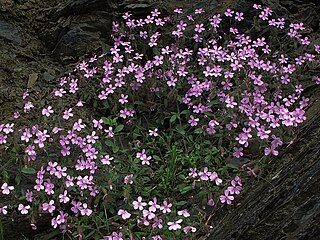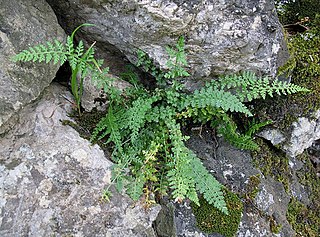
Asplenium is a genus of about 700 species of ferns, often treated as the only genus in the family Aspleniaceae, though other authors consider Hymenasplenium separate, based on molecular phylogenetic analysis of DNA sequences, a different chromosome count, and structural differences in the rhizomes. The type species for the genus is Asplenium marinum.
Asplenium ascensionis is a species of fern in the family Aspleniaceae. It is endemic to Ascension Island. Its natural habitats are receding due to introduced vegetation. It is threatened by habitat loss.
Asplenium bifrons is a species of fern in the family Aspleniaceae. It is endemic to Ecuador. It is known only from one population in Pichincha Province. Its natural habitat is subtropical or tropical moist montane forests. It is threatened by habitat loss for hydroelectric power.

Hymenasplenium cardiophyllum is a species of fern in the family Aspleniaceae. It is native to China and Japan. Its natural habitat is subtropical or tropical moist lowland forests. It is threatened by habitat loss.
Asplenium congestum is a species of fern in the family Aspleniaceae. It is endemic to Ecuador. Its natural habitats are subtropical or tropical moist lowland forests and subtropical or tropical moist montane forests. It is threatened by habitat loss for agriculture.
Asplenium ecuadorense is a species of fern in the family Aspleniaceae. It is endemic to Ecuador. Its natural habitats are subtropical or tropical moist lowland forests and subtropical or tropical moist montane forests. It is threatened by habitat loss.
Asplenium schweinfurthii is a species of fern in the family Aspleniaceae. It is endemic to Yemen. Its natural habitats are subtropical or tropical dry forests and subtropical or tropical dry shrubland. It is threatened by habitat loss.
Asplenium virens is a species of fern in the family Aspleniaceae. It is endemic to Ecuador, where it is found in coastal forests. This habitat is fragmented and degraded, and habitat loss is the main threat to the species.

Asplenium ceterach is a fern species commonly known as rustyback.

Asplenium antiquum is a fern of the group known as bird's-nest ferns. In Japanese it is known by ō-tani-watari and tani-watari.
Asplenium daghestanicum, the Dagestanian spleenwort, is a species of spleenwort that is endemic to Dagestan in Russia. It is known only from Agulsky and Khivsky districts. It can be found on shaded schist rocks in the middle montane zone, at elevations from 1,800 to 2,300 m. Its population is estimated to be 1,500–2,000 mature individuals. It is threatened by the effects of climate change on its microhabitat.
Asplenium hermannii-christii, Hermann Christ's asplenium, is a species of spleenwort that is endemic to Georgia. It is known from only one location, in the Bzyb River gorge in Abkhazia. It can be found on calcareous rock crevices in the lower montane zone, from elevations of 150–170 m. It is threatened by recreational activities. This species is named after fern botanist Konrad H. Christ.

Asplenium schizotrichum is a species of spleenwort that is endemic to the island of Rarotonga in the Cook Islands. Its population is estimated to be less than 20 mature individuals.

Petrocoptis pseudoviscosa, commonly known as falguera, is a species of plant in the family Caryophyllaceae. It is endemic to the Spanish province of Huesca, where it is only known from the Valle del Ésera in the Pyrenees. Its natural habitat is calcareous cliffs, crags and caves.

Asplenium fontanum, commonly known as fountain spleenwort or smooth rock spleenwort, is a species of fern in the family Aspleniaceae, native to rocky areas in Western Europe.
Asplenium haughtonii, also known as the Barn fern, is a species of fern in the family Aspleniaceae. It is native to Saint Helena.
Asplenium complanatum is a species of fern in the family Aspleniaceae. It is native to Seychelles. It is listed as critically endangered by the IUCN.
Asplenium dielfalcatum is a species of fern in the family Aspleniaceae. It is native to Oahu, Hawaii.

Asplenium hemionitis is a species of fern native to Macaronesia, Northwest Africa and mainland Portugal. It inhabits humid woods and other shady areas, sometimes in uncovered slopes subject to high ocean humidity.








